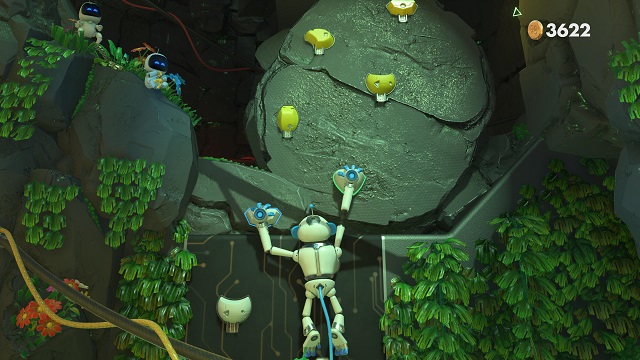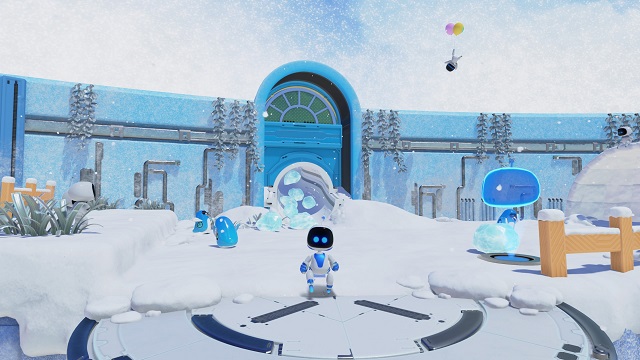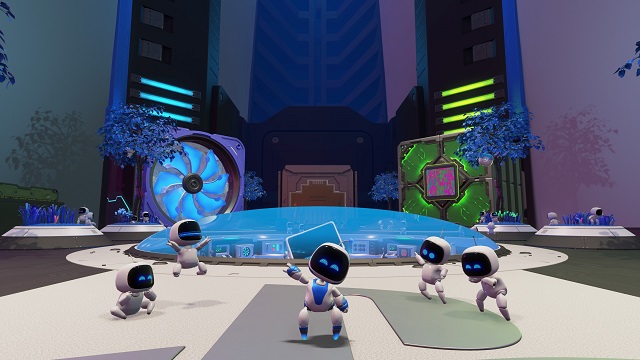Astro’s Playroom wasn’t on my list of most-anticipated PS5 launch games. That distinction went to Demon’s Souls and Spider-Man: Miles Morales. In many ways, Astro’s was, in my early estimation, not much more than a gimmicky tech demo showing off the power of the DualSense controller.
While it is kind of a tech demo, and there are some gimmicks, it’s also one of the best platformers I’ve played in years. Astro’s Playroom is a true gem and another feather in Sony’s cap. It’s marvelous, and I can’t stop thinking about it.
Astro’s Playroom Review: Pure, Imaginative Fun
I received my PS5 on launch day. Setting it up, all I could think about was getting back to Boletaria and seeing Demon’s Souls in its next-gen glory. But after setting everything up and transferring some of my PS4 games to the PlayStation 5, I started with Astro’s Playroom.
And oh, wowie am I glad I did.
Astro’s Playroom is a showcase for the new haptic technology baked into the DualShock 4’s successor, the DualSense. In some ways, a review for Astro’s is a review for the PS5 controller itself, but I’m saving some of that info for a full-on DualSense review later.
The TL;DR here is that the DualSense mimics and/or outright recreates real-life textures in games that support its many different features. And with Astro’s being the launch-day showcase it is, the way the game uses the DualSense to recreate myriad textures and sensations are revolutionary in execution.
How well this works is hard to explain, but metal feels like metal, wood feels like wood, and mud feels like mud. If you’re walking over a corrugated floor, for example, you feel the peaks and troughs in its design. With very few exceptions, you know exactly what you’re walking on, through, or over.
The same can be said for the sensation of rain and hail as they pitter off of Astro’s little umbrella, peppering the DualSense in light and heavy thumps, as well as that of rumbling thunder as it rolls over distant platforms toward you, through you, and past you. Drawing a bow has distinct weight and resistance, and firing a machine gun that shoots little squishy balls puts the most rumble and force on the trigger (R2) before waning in energy across the controller from right to left.
The way the haptics work in concert to create hundreds of different textures and sensations is techno sorcery through and through, and it’s something you’ll want to share with everyone who will indulge you and pick up the DualSense at your urging.
It helps that the controller’s built-in speaker produces small auditory clues along the way. Though the haptics do much of the legwork, sound plays a big role in crafting a full sensory experience here. Metal pings and grass rustles. Wood thumps and plastic thunks.
And while Astro’s Playroom makes good use of the PS5’s 3D audio, where rocket thrusters boom with power all around you or the gust of a strong easterly wind rushes and swirls through your right ear, the full experience is more immersive by simply using the DualSense’s built-in speaker.

At its core, Astro’s Playroom is an excellent platformer literally set inside a PS5. As a stand-alone package, removed from all of the pomp and circumstance of the DualSense, it employs the best parts of the genre and diversifies its gameplay just enough to stay fresh for its three- to four-hour runtime.
There are four worlds and 16 levels to explore in the game, as well as a general world hub, a speedrun hub, and what amounts to an interactive PlayStation museum, PlayStation Labo. Each of the imaginative worlds is subdivided into four sublevels, where platforming stages alternate with those that put Astro in a unique suit that shows off more of what the DualSense is capable of.
Cooling Springs is a water- and ice-based world that features a springy frog suit you move by tilting the controller while holding and releasing either “L2” or “R2,” diving boards, and even ice skating (perhaps the best and most realistic sensation in the game). Memory Meadow is a grassy world that features a ball suit you can move in all directions with the touchpad, some light bowling, and lots of mud, wind, and rain.
SSD Speedway is a beautiful neon futurescape that showcases the game’s verticality in gripping ways and features a rocketship suit, hang gliding, and that kinetic and powerful ball-shooting machine gun I mentioned earlier. Finally, GPU Jungle is, well, a vibrant jungle that features a monkey suit used for climbing and swinging, wind puzzles, and one of the game’s only boss battles.
You might think there’s lots of motion control and button pressing going on, and you’d be right. But there’s a nuance to it all that makes each suit stand out.
The springy frog suit feels just like a spring, and the amount of pressure you put on the triggers is reminiscent of pushing an actual spring down and letting it go. In the monkey suit, you tilt the controller just as you would tilt your shoulders when reaching up to grab something, and certain handholds require minimal pressure to grab, while others require full force, underlining the unique nature of the DualSense’s adaptive triggers.

It’s hard to ignore that Astro’s Playroom takes a lot of inspiration from games like Crash Bandicoot and, perhaps most obviously, Super Mario. In many ways, this is the most Nintendo thing Sony’s ever published.
In the platforming levels, Astro has a spin attack similar to the one found in Crash and a jump attack akin to Mario’s. The difference here is that the spin attack must be charged, and the jump attack trades plumber boots for jetpack boots. There’s also a regular punch thrown in for good measure.
Enemy variety is relatively generic and reminiscent of those games, but nonetheless fitting and endearing. Some enemies rush you with spikes bared, others try to blow you up by blowing themselves up, and still, others smash the ground while trying to catch you in their electric shockwave. None are meant to be difficult by themselves, but when grouped together, they can, at times, present a challenge.
The environments themselves can sometimes be trickier than enemies in some sections, with pools of frozen water instantly freezing you if fall in and walls of exposed wires shocking you to death if you run into them. Platforms rotate, move back and forth, and disappear above endless chasms that lead to instant death, and there are tightropes to balance, mountains to climb, and asteroids to fly through, all with some type of hazard waiting for you to make a mistake.
If you do die, Astro‘s checkpoint system is extremely generous, almost always starting you close to where you gave up the ghost. It’s a double-edged sword because while you’ll never have to slog through a level, the system makes the game’s already-low difficulty even lower.
Replayability mostly comes in the game’s speedrun mode, which unlocks after you complete one of the four worlds. You can access these levels separate from the worlds themselves, and smartly, none of them recreate any of the game’s levels.
On top of that, Astro’s Playroom is like a living PlayStation history book, jam-packed with references to games like Final Fantasy 7, Bloodborne, and Jak & Daxter. Levels are full of collectibles (142, in fact) that range from full system models to obscure peripherals. Puzzle pieces can also be collected to build a decades-spanning PlayStation mural that adorns the walls of PlayStation Labo, the place where you can see all of these artifacts on display in unbelievably stunning detail.
Astro’s Playroom Review — The Bottom Line

Pros
- Fantastic DualSense showcase
- Creative use of haptics and adaptive triggers
- Beautiful, vibrant environments
- Witty, memorable soundtrack
- Tight, responsive controls
- PlayStation Labo
Cons
- Too short
- Limited enemy variety
It’s clear that ASOBI Team poured their heart and soul into Astro’s Playroom, developing a meticulously detailed pack-in title that proves the power of the DualSense while also taking players through the entire history of PlayStation in unprecedented fashion.
As a life-long PlayStation fan, the enormity of PlayStation Labo is reason enough to play through Astro’s Playroom for all of the collectibles — and to revisit it again and again over the life of the PS5.
Though it’s short and may lack enemy variety, Astro’s Playroom makes up for it in character and heart. It’s a stunning display of the thought and care Sony has put into the DualSense controller. And it’s a solid platformer that everyone should play at least once.
If we’re lucky, we’ll get a full-on Astro Bot platformer in the future. Here’s to hoping.
[Note: The copy of Astro’s Playroom used for this review was included on the writer’s retail PlayStation 5.]







Published: Nov 14, 2020 09:58 pm